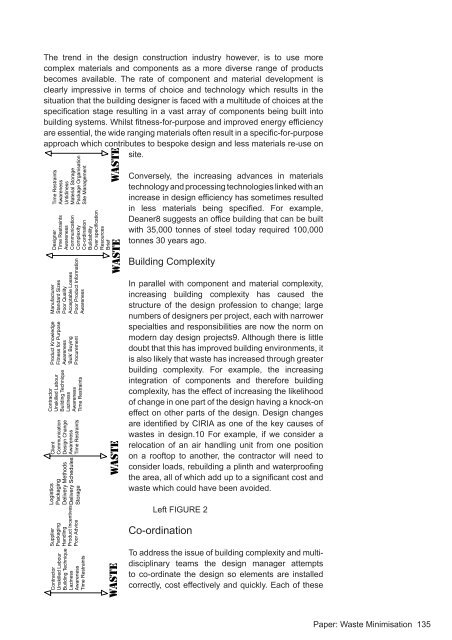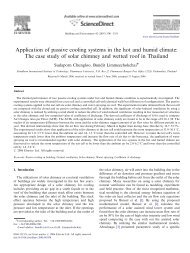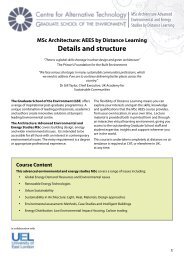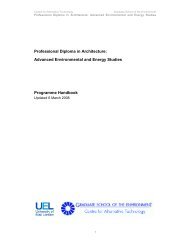Module B1 Study Book - the Graduate School of the Environment
Module B1 Study Book - the Graduate School of the Environment
Module B1 Study Book - the Graduate School of the Environment
You also want an ePaper? Increase the reach of your titles
YUMPU automatically turns print PDFs into web optimized ePapers that Google loves.
The trend in <strong>the</strong> design construction industry however, is to use more<br />
complex materials and components as a more diverse range <strong>of</strong> products<br />
becomes available. The rate <strong>of</strong> component and material development is<br />
clearly impressive in terms <strong>of</strong> choice and technology which results in <strong>the</strong><br />
situation that <strong>the</strong> building designer is faced with a multitude <strong>of</strong> choices at <strong>the</strong><br />
specification stage resulting in a vast array <strong>of</strong> components being built into<br />
building systems. Whilst fitness-for-purpose and improved energy efficiency<br />
are essential, <strong>the</strong> wide ranging materials <strong>of</strong>ten result in a specific-for-purpose<br />
approach which contributes to bespoke design and less materials re-use on<br />
site.<br />
Time Restraints<br />
Awareness<br />
Untidiness<br />
Material Storage<br />
Package Organisation<br />
Site Management<br />
Designer<br />
Time Restraints<br />
Awareness<br />
Communication<br />
Complexity<br />
Co-ordination<br />
Buildability<br />
Over specification<br />
Resources<br />
Brief<br />
Manufacturer<br />
Standard Sizes<br />
Poor Quality<br />
Acceptable Losses<br />
Poor Product Information<br />
Awareness<br />
Product Knowledge<br />
Fitness for Purpose<br />
Awareness<br />
‘Bulk’ Buying<br />
Procurement<br />
Contractor<br />
Unskilled Labour<br />
Building Technique<br />
Laziness<br />
Awareness<br />
Time Restraints<br />
Client<br />
Communication<br />
Design Change<br />
Awareness<br />
Time Restraints<br />
Logistics<br />
Packaging<br />
Delivery Methods<br />
Delivery Schedules<br />
Storage<br />
Supplier<br />
Packaging<br />
Handling<br />
Product Incentives<br />
Poor Advice<br />
Contractor<br />
Unskilled Labour<br />
Building Technique<br />
Laziness<br />
Awareness<br />
Time Restraints<br />
Waste Waste Waste<br />
Waste<br />
Conversely, <strong>the</strong> increasing advances in materials<br />
technology and processing technologies linked with an<br />
increase in design efficiency has sometimes resulted<br />
in less materials being specified. For example,<br />
Deaner8 suggests an <strong>of</strong>fice building that can be built<br />
with 35,000 tonnes <strong>of</strong> steel today required 100,000<br />
tonnes 30 years ago.<br />
Building Complexity<br />
In parallel with component and material complexity,<br />
increasing building complexity has caused <strong>the</strong><br />
structure <strong>of</strong> <strong>the</strong> design pr<strong>of</strong>ession to change; large<br />
numbers <strong>of</strong> designers per project, each with narrower<br />
specialties and responsibilities are now <strong>the</strong> norm on<br />
modern day design projects9. Although <strong>the</strong>re is little<br />
doubt that this has improved building environments, it<br />
is also likely that waste has increased through greater<br />
building complexity. For example, <strong>the</strong> increasing<br />
integration <strong>of</strong> components and <strong>the</strong>refore building<br />
complexity, has <strong>the</strong> effect <strong>of</strong> increasing <strong>the</strong> likelihood<br />
<strong>of</strong> change in one part <strong>of</strong> <strong>the</strong> design having a knock-on<br />
effect on o<strong>the</strong>r parts <strong>of</strong> <strong>the</strong> design. Design changes<br />
are identified by CIRIA as one <strong>of</strong> <strong>the</strong> key causes <strong>of</strong><br />
wastes in design.10 For example, if we consider a<br />
relocation <strong>of</strong> an air handling unit from one position<br />
on a ro<strong>of</strong>top to ano<strong>the</strong>r, <strong>the</strong> contractor will need to<br />
consider loads, rebuilding a plinth and waterpro<strong>of</strong>ing<br />
<strong>the</strong> area, all <strong>of</strong> which add up to a significant cost and<br />
waste which could have been avoided.<br />
Left FIGURE 2<br />
Co-ordination<br />
To address <strong>the</strong> issue <strong>of</strong> building complexity and multidisciplinary<br />
teams <strong>the</strong> design manager attempts<br />
to co-ordinate <strong>the</strong> design so elements are installed<br />
correctly, cost effectively and quickly. Each <strong>of</strong> <strong>the</strong>se<br />
Paper: Waste Minimisation 135











